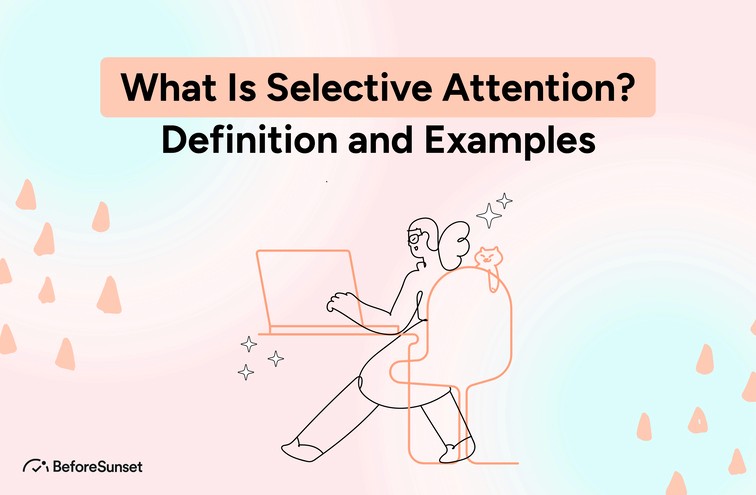A cognitive mechanism called selective attention enables a person to concentrate their awareness on a certain subset of information while ignoring or filtering out other unnecessary information. In essence, it's the capacity to focus while ignoring distractions or less important inputs on a given activity, stimulus, or piece of information.
At any given time, a tremendous number of sensory inputs are being sent into our sensory systems. Selective attention improves our ability to process information more quickly and prioritize what we observe and process.

Role of Selective Attention
A key entrance to human perception and cognition is provided by the cognitive mechanism of selective attention. Our brains are constantly being inundated with a massive quantity of information in a world that is overflowing with sensory data.
Filtering through this sensory onslaught and highlighting the most pertinent and significant stimuli is the function of selective attention. This permits us to concentrate on what really important in a given situation and efficiently use our limited cognitive resources.
Think about attempting to read a book in a busy café. Selective attention enables you to concentrate on the text on the page while blocking out background noise, such as conversations and dish clinking.
For attention to be maintained and knowledge to be retained, one must be able to focus only on the work at hand while disregarding distractions. Selective attention makes ensuring that our cognitive efforts are focused on the task's essential components whether we are reading, working, or having a meaningful discussion.
Selective attention improves our perception and comprehension of the world in addition to blocking off distractions. It helps the organizing of sensory data into coherent patterns and meaningful structures by helping us focus on certain inputs.
Selected attention enables us to recognize specific trees, creatures, and other aspects that add to our comprehension of the whole when seeing a complex sight, such as a forest setting. We are able to make sense of our surroundings and make decisions because of this perceptual architecture.
Visual Attention
The fundamental cognitive function of visual attention affects how we perceive and engage with the visual environment around us. Our capacity to focus on particular features while filtering out distractions amid a universe of visual stimulation ranging from minute details to expansive landscapes is nothing short of amazing.
Visual attention affects not only our current perception but also how we remember things, make choices, and use our brains in general.
Visual Stimuli and Selective Attention
Visual stimuli, which include everything we perceive in our surroundings, from colors and forms to textures and motions, serve as the foundation for our visual experiences. The amount of sensory information that our visual system must deal with at any given time, however, vastly exceeds what our brain can handle at once.
Here, selective attention serves as a critical cognitive filter to decide which visual stimuli are given first priority for processing and which ones are pushed to the background.
Think about traversing a busy city street. Billboards, moving traffic, pedestrians, businesses, and a plethora of other things all compete for your attention.
Reading a traffic sign or dodging obstacles are only two examples of how visual attention enables you to concentrate on particular components that are in line with your present aims or interests while disregarding the plethora of information that is less important to your current goals.
It is not just a survival mechanism but also a cognitive tactic that improves our effectiveness and understanding and allows us to concentrate on some visual stimuli while shutting out others.
For instance, when reading a book, your visual attention helps you extract meaning from the text by guiding your gaze from word to word and line to line. Similar to this, while looking for a buddy in a busy environment, your focus directs your eyes to faces while excluding the items in the immediate vicinity.

Visual Cortex and Neural Processing
The visual cortex is a highly specialized area of the brain that plays a central role in processing visual information and constructing our perception of the visual world. It's located at the back of the brain, primarily in the occipital lobes, and is divided into different regions that specialize in various aspects of visual processing. The complex neural processing within the visual cortex transforms raw visual input into meaningful representations that guide our perception and understanding of the environment.
Visual processing begins with the reception of visual stimuli by the photoreceptor cells in the retina, located at the back of the eye. These cells convert light into electrical signals that are transmitted through the optic nerve to the brain. Upon reaching the visual cortex, the information undergoes a series of hierarchical and parallel processing stages.
Feature Detection and Early Processing:
In the early stages of visual processing, the visual cortex is responsible for detecting basic visual features such as edges, lines, angles, and colors. This process is often referred to as feature detection. Neurons in the visual cortex are highly specialized to respond to specific visual attributes, and their arrangement in different layers contributes to the extraction of different features.
Orientation and Shape Detection:
As processing continues, specific regions within the visual cortex become involved in more complex tasks such as orientation and shape detection. Neurons in these regions respond to specific orientations of lines or edges, contributing to the perception of forms and objects in the visual field.
Object Recognition and Higher-Level Processing:
Moving along the processing hierarchy, the visual cortex engages in more intricate functions like object recognition. As visual information progresses through different regions, it becomes increasingly abstract and complex. Neurons in certain areas respond selectively to specific objects, faces, or even scenes. These areas are vital for our ability to recognize familiar faces, objects, and places.
Motion Processing:
The visual cortex also contains areas specialized in processing motion. These areas analyze the direction and speed of moving objects, enabling us to perceive movement accurately and react to dynamic changes in our environment.
Visual Pathways:
There are two primary visual pathways that emerge from the visual cortex: the dorsal (or "where") pathway and the ventral (or "what") pathway. The dorsal pathway processes spatial information and contributes to the perception of the location and motion of objects. The ventral pathway, on the other hand, focuses on object recognition and attributes such as color and shape.
Cognitive Abilities and Visual Field
Cognitive abilities and the visual field are closely interconnected, with our cognitive processes working in tandem with our visual perception to construct a coherent understanding of the world. The visual field refers to the entirety of our surroundings that we can perceive with our eyes, and cognitive abilities are the mental processes that enable us to process, interpret, and make sense of the information within our visual field. Here's how cognitive abilities interact with the visual field:
Object Recognition:
One of the key cognitive abilities is object recognition, which involves identifying and categorizing objects based on their visual features. Our visual field is filled with various objects of different shapes, colors, and sizes. Cognitive processes help us recognize familiar objects, such as faces, animals, and everyday items, even when they appear in different orientations or contexts within our visual field.
Pattern Recognition:
Pattern recognition is the cognitive process that allows us to detect recurring arrangements of elements in our visual field. This ability is crucial for identifying textures, designs, and even abstract concepts. For instance, recognizing letters as words and words as sentences involves pattern recognition.
Spatial Awareness:
Cognitive abilities help us understand the spatial relationships between objects in our visual field. We can judge distances, perceive depth, and comprehend the three-dimensional nature of our environment. This spatial awareness is essential for tasks like navigating through a crowded room or estimating the size of objects.
Attention and Selective Focus:
Cognitive processes guide our attention within the visual field. While the entire visual field is accessible to our eyes, we can only focus on a limited portion at any given moment. Cognitive abilities play a role in directing our attention to specific areas or objects of interest, allowing us to concentrate on relevant details and ignore distractions.
Visual Search and Exploration:
Exploring the visual field often involves visual search, where we scan the environment to find a specific target or locate relevant information. Cognitive processes help us efficiently search for objects, faces, or cues based on our goals, memory, and expectations.
Memory Formation:
Our cognitive abilities also contribute to memory formation based on the information in our visual field. When we observe something in our visual environment, cognitive processes work to encode that information into memory, allowing us to recall and retrieve it later.
Problem Solving:
As we encounter challenges and problems within our visual field, cognitive abilities like reasoning and problem-solving come into play. These abilities help us analyze the situation, devise strategies, and make decisions to address the challenges effectively.

Effects of Visual Stimuli on Attention
Visual stimuli have a profound impact on attention, influencing how we allocate our cognitive resources and focus our awareness. The effects of visual stimuli on attention can be understood through several key mechanisms:
Salience and Capture: Visual stimuli that are highly salient or novel tend to capture attention involuntarily. Bright colors, sudden movements, and distinctive shapes can trigger an automatic shift of attention toward the stimulus, diverting our focus from what we were previously engaged in.
Selective Focus: Visual stimuli can guide our selective attention by directing us to specific areas or objects within our visual field. For example, in a crowded room, a friend waving their hand will naturally draw our attention, helping us filter relevant information from the environment.
Visual Competition: When multiple visual stimuli are present simultaneously, they can compete for our attention. Stronger or more relevant stimuli often win this competition and become the primary focus of our attention, while weaker stimuli are suppressed or ignored.
Feature-based Attention: Visual stimuli with distinct features, such as a unique color or shape, can attract attention based on those features alone. This mechanism allows us to locate specific items quickly, like finding a red apple in a pile of green ones.
Task Relevance: The relevance of visual stimuli to our current goals or tasks significantly impacts our attention. Relevant stimuli are more likely to be attended to, while irrelevant stimuli may be filtered out or processed at a lower level of detail.
Attentional Blink: Rapid succession of visual stimuli can lead to a phenomenon known as the attentional blink. In this scenario, if a second stimulus is presented shortly after the first, it might not be consciously perceived because our attention is momentarily "blinking" or disengaged after the first stimulus.
Visual Clutter: An environment with excessive visual stimuli, such as a cluttered desk or a busy street, can make it challenging to focus attention effectively. The abundance of stimuli can lead to divided attention or difficulty in selecting the most important information to process.
Emotional Impact: Emotionally charged visual stimuli, such as a shocking image or a smiling face, can evoke a stronger attentional response due to the brain's inherent interest in processing emotional content.
Inhibition of Return: After attending to a specific location, our attention may briefly resist returning to the same location, even if a stimulus appears there. This mechanism aids in scanning the environment efficiently without repeatedly revisiting the same spot.
Cultural and Personal Factors: Our cultural background, personal experiences, and interests also influence how we allocate attention to different visual stimuli. What may be attention-grabbing for one person might not hold the same significance for another.
Auditory Attention
Auditory attention forms the cornerstone of our ability to navigate the intricate world of sound. In a universe filled with a symphony of auditory stimuli, ranging from whispered conversations to thunderous applause, our capacity to selectively focus on specific sounds while filtering out distractions is a remarkable feat of cognitive processing.
Auditory attention allows us to pinpoint conversations in noisy environments, detect subtle nuances in music, and react swiftly to sudden auditory cues.
Auditory Stimuli and Selective Attention
Auditory stimuli and selective attention are intricately intertwined, working together to shape our perception of sound and prioritize relevant auditory information. Auditory stimuli encompass the wide array of sounds that we encounter in our environment, from the gentle rustling of leaves to the rhythmic beats of music. Selective attention, on the other hand, is the cognitive process that allows us to focus on specific auditory stimuli while filtering out others, ensuring that our cognitive resources are efficiently allocated to what matters most in a given context.
Soundscape Filtering:
Imagine standing in a bustling market. The auditory stimuli are diverse and overlapping – voices, footsteps, traffic, and more. Selective attention enables you to focus on a particular conversation while effectively filtering out the surrounding noise. This process is essential for engaging in meaningful conversations and comprehending spoken language in challenging acoustic environments.
Targeting Relevant Information:
In various situations, we direct our auditory attention to specific sounds that are relevant to our goals. For instance, a lifeguard at a pool may be adept at tuning into the sounds of splashing water or distressed calls for help amidst the cacophony of poolside activities.
Dichotic Listening:
In psychological experiments, researchers use a technique called dichotic listening to study selective auditory attention. Participants are presented with different sounds in each ear simultaneously and are instructed to focus on one ear's input while ignoring the other. This demonstrates our ability to prioritize one stream of auditory information over another.
Auditory Processing and Neural Basis
Incoming sound waves are converted into meaningful auditory experiences through an elaborate series of brain activities known as auditory processing. The capacity of the brain to decipher different acoustic characteristics, such as pitch, timing, position, and timbre, and transform them into sensations like speech, music, and ambient noises is a complicated process. Several significant brain regions and circuits are involved in the neurological underpinnings of auditory processing:
1. Cochlea: The cochlea, an inner ear structure with a spiral shape, is where auditory processing begins. By turning on hair cells that recognize various frequencies, it transforms sound waves into brain messages. These cells are arranged tonotopically, which means they respond to particular frequencies and affect how we perceive pitch.
2. Auditory Nerve: The auditory nerve transmits neurological impulses from the cochlea to the brainstem, which further encodes fundamental aspects of sound, such as loudness and timing.
3. Brainstem: Auditory nuclei in the brainstem handle fundamental auditory information, such as the distinction between speech and other sounds. This first processing helps identify the origin of sounds and identify significant alterations in the auditory environment.
4. Auditory Cortex: The complex processing of auditory information takes place in the auditory cortex, which is a structure in the temporal lobe. It is divided into several parts, each of which controls a distinct component of hearing. Basic sound analysis, including processing of frequency and temporal information, depends on the primary auditory cortex (A1). Complex activities including voice recognition, sound localization, and music perception demand higher-order auditory regions.
5. Tonotopic Organization: The auditory cortex is tonotopically structured, just as the cochlea. Our capacity to distinguish between pitches and intricate auditory patterns is influenced by the selective responses of neurons in various locations to particular frequencies.
6. Auditory Pathways: The dorsal ("where" or "how") and ventral ("what") pathways are the two primary pathways via which auditory processing takes place. The dorsal route, which is linked to the parietal cortex, concentrates on the spatial characteristics of sound and aids in determining where auditory inputs come from. The identification and interpretation of auditory information, such as speech and music, is the responsibility of the ventral pathway, which connects with the temporal cortex.
7. Auditory Attention: The prefrontal cortex, parietal cortex, and superior colliculus are just a few of the brain areas that interact to provide the neurological foundation of auditory attention. Together, these regions accelerate the processing of pertinent auditory information and eliminate distractions.
8. Plasticity: The brain can adjust to changes in auditory input thanks to its plasticity. People who are born blind, for instance, frequently have improved auditory processing and a more substantial representation of hearing information in the visual brain.
Prefrontal Cortex and Cocktail Party Effect
A crucial part of the brain that controls higher-order cognitive processes including judgment, problem-solving, and social conduct is called the prefrontal cortex. This region controls attention and filters sensory inputs in the front of the brain, where it is located.
The "cocktail party effect" is an intriguing occurrence that demonstrates the prefrontal cortex's talents. The capacity of the brain to selectively focus on one discussion in the middle of a cacophony of other talks and background noise in a crowded place is demonstrated by this phenomenon.
The prefrontal cortex, along with other brain areas, makes it possible for people to engage in social interactions productively even in loud environments by improving the processing of pertinent auditory cues and aiding the suppression of irrelevant distractions.

